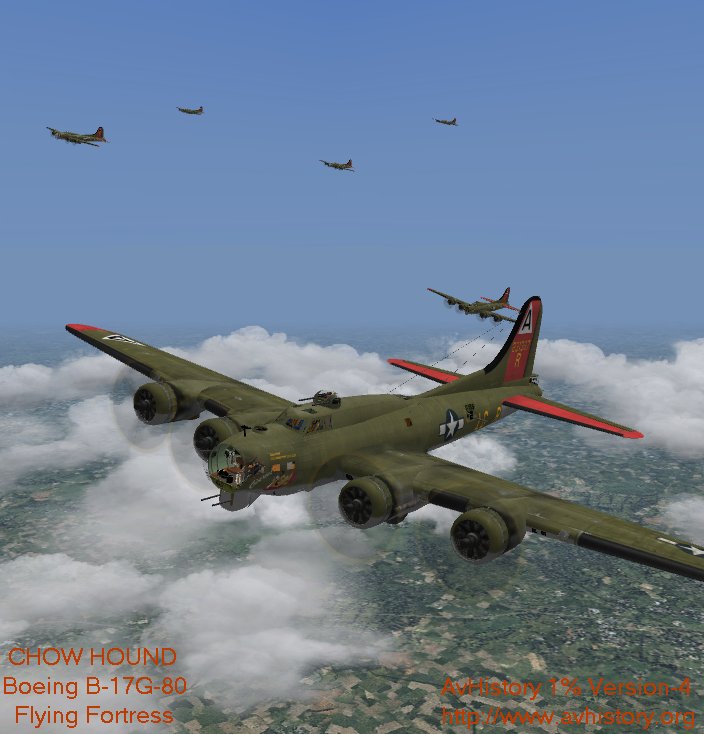CHOW HOUND
Boeing Flying Fortress B-17G-80
AvHistory - Version-4.00.100

Gregory Pierson's Version 4.0 first released in August 2006 represents a complete update of the AvHistory 1% Assembly Line Process (1%ALP). Compared to our previous efforts, 4.0 is an order of magnitude improvement and a closer step towards our goal of producing aircraft that perform within 1% of the real aircraft. For additional info on Version-4 flight packages see the included AvHistory -Version-4 1%ALP text file.
AIRCRAFT BACKGROUND:
HerbieG created this outstanding B-17G visual as the successor to his famous CFS2 MOLLY. John BRAVO/4 Whelan of the Ground Crew painted Herbie's plane as "CHOW HOUND"

B-17G Tail No. 42-31367 flew out of Bassingbourn, England assigned to the 322nd Squadron of the 91st Bomb group. Lieutenant Jerry Newquist and crew flew 30 missions completing their tour of duty.

Lieutenant Jerry Newquist Crew.
Lt. Jack Tompson and crew took over Chow Hound and on August 8th, 1944 the aircraft was shot down over France. Four out of Thompson's nine man crew were killed the rest were POW's till the war ended.
The B-17G was introduced onto the production line in July of 1943, and was destined to be produced in larger numbers than any other Fortress variant. The most readily-noticeable innovation introduced by the B-17G was the power-operated Bendix turret mounted in a chin-type installation underneath the nose. This turret was equipped with two 0.50-inch machine guns.
Another feature introduced by the G was having the waist guns being permanently enclosed behind windows instead of being mounted behind removeable hatches. This made the rear fuselage somewhat less drafty.
The cheek nose guns introduced on the late B-17F were retained, but were staggered so that the left gun was in the forward side window and the right gun was in the middle side window, which reversed the positions used on the late Fs. The cheek gun mounts bulged somewhat outward into the airstream, which helped to improve the forward view from the cheek gun positions.
B-17Gs were built by all three members of the "BVD" production pool, with the Boeing lots ranging from production blocks G-1 to G-110, the Douglas blocks ranging from 5 to 95, and the Lockheed-Vega blocks ranging from 1 to 110. The B-17G entered service with the Eighth and Fifteenth Air Forces in late 1943.
The so-called "Cheyenne" tail gun mounting modifications were incorporated in the B-17G-80-BO, -45-DL, -35-VE and subsequent batches. These tail gun mountings also had a reflector gunsight instead of the previous ring and bead. With this installation, these B-17Gs were five inches shorter than the earlier versions.
On later production versions, it was found necessary to stagger the waist gun positions so that the two gunners would not get in each other's way.
On the last production batches (B-17G-105 and -110-BO, B-17G-75 to -85-DL, and B-17G-85 to -110-VE), the radio compartment gun was not installed. The ammunition capacity of the waist guns was increased to 600 rpg.
When production finally terminated in 1945, a total of 4035 B-17Gs had been built by Boeing, 2395 by Douglas, and 2250 by Lockheed-Vega. The last Boeing-built B-17G was delivered on April 13, 1945. J. Baugher.
NOTE: The HG_Shared.zip, Charlie's Bomber Base Extension "CFS3Bulldozez.Zip" & the Version 4 AvHistory Guns - Weapons.zip should be installed with this aircraft. Links to the zip files at AvHistory are provided in the installation readme.
A B-17G will break ground at about 4,500ft @ 65,000lbs but since its climb rate is very low any hills, trees or both at the end of the runway will cause you problems. The Bomber Base Extension Package created by Charles "CHARLIE" Simpson for this project gives you an extra safety margin at these airbases.
At high gross weights the aircraft may lift off the runway but may not be able to climb out of ground effect until sufficient flying speed is reached. Also, if you get shot up and lose 1 or more engines the aircraft may not be able to maintain altitude.
Should you be over the ocean/channel you may descend until you enter ground effect where you may be able to limp home skimming across the water. For reference, ground effect extends for about 2 wingspans above the ground.
Each aircraft is different and each aircraft has it's own unique ground effect pattern.
You will also be needing it for a number of the other 4 engine bombers that will be released.
As is usual please report any problems or issues to AvHistory 1% Squawks at
http://www.avhistory.org/scripts/Meg....asp?forumid=3for the fastest responce. We will also be checking in on the major CFS3 boards but our responce may be a bit slower.
BEAR - AvHistory Team
http://www.avhistory.org

